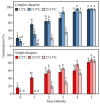Diaspore Dimorphism, Awn Hygroscopicity and Adaptive Significance in a Winter Annual Bromus tectorum (Poaceae)
- PMID: 39520011
- PMCID: PMC11548731
- DOI: 10.3390/plants13213093
Diaspore Dimorphism, Awn Hygroscopicity and Adaptive Significance in a Winter Annual Bromus tectorum (Poaceae)
Abstract
Bromus tectorum, a winter annual plant, produces dimorphic diaspores: complex diaspores with multi-awns and simple diaspores with one awn. However, there is no information available about the role of awns and the germination characteristics of dimorphic diaspores. Dispersal germination and awns hygroscopicity of the dimorphic diaspores were assessed. The complex diaspore with multi-awns can easily be dispersed long distances from the mother plant by mammals. The simple diaspores with one awn are tightly attached to the mother plant. Caryopses from the two types of diaspores exhibited non-deep physiological dormancy at maturity, which can be released by dry storage and GA3 treatment. The awns have hygroscopic activity and can move in response to changes in moisture, moving the complex diaspore (the seed) into the soil. The seedling emergence from complex diaspores was significantly higher than those from simple diaspores at all burial depths. Germination of caryopses on the soil surface was poor. The optimal planting depth for both types of diaspores' emergence is 1-2 cm. The distinct characteristics of dimorphic diaspores and the beneficial influence of hygroscopic awns on dispersal, germination, and seedling establishment have significant ecological implications for B. tectorum's successful reproduction in unpredictable cold deserts.
Keywords: after-ripening; dimorphic diaspore; dispersal; hygroscopic awns; seedling emergence; self-burial of seeds.
Conflict of interest statement
The authors declare no conflicts of interest.
Figures









Similar articles
-
Awn length variation and its effect on dispersal unit burial of Trachypogon spicatus (Poaceae).Rev Biol Trop. 2014 Mar;62(1):321-6. Rev Biol Trop. 2014. PMID: 24912361
-
Soil salinity regulates spatial-temporal heterogeneity of seed germination and seedbank persistence of an annual diaspore-trimorphic halophyte in northern China.BMC Plant Biol. 2024 Jun 26;24(1):604. doi: 10.1186/s12870-024-05307-x. BMC Plant Biol. 2024. PMID: 38926703 Free PMC article.
-
Trade-offs between diaspore dispersal and dormancy within a spike of the invasive annual grass Aegilops tauschii.Planta. 2023 May 18;257(6):121. doi: 10.1007/s00425-023-04156-6. Planta. 2023. PMID: 37198315
-
Diverse ecological functions and the convergent evolution of grass awns.Am J Bot. 2022 Sep;109(9):1331-1345. doi: 10.1002/ajb2.16060. Epub 2022 Sep 26. Am J Bot. 2022. PMID: 36048829 Free PMC article. Review.
-
Morphological and Genetic Mechanisms Underlying Awn Development in Monocotyledonous Grasses.Genes (Basel). 2019 Jul 30;10(8):573. doi: 10.3390/genes10080573. Genes (Basel). 2019. PMID: 31366144 Free PMC article. Review.
References
-
- Walck J.L., Hidayati S.N., Dixon K.W., Thompson K., Poschlod P. Climate change and plant regeneration from seed. Global Change Biol. 2011;17:2145–2161. doi: 10.1111/j.1365-2486.2010.02368.x. - DOI
-
- Kesseler R., Stuppy W. Seeds: Time Capsules of Life. Earth Aware Editions; San Rafael, CA, USA: 2012.
-
- Venable D.L., Brown J.S. The population-dynamic functions of seed dispersal. Vegetatio. 1993;108:31–55. doi: 10.1007/BF00052210. - DOI
Grants and funding
LinkOut - more resources
Full Text Sources

